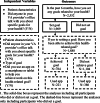Health-Related Goal Setting and Achievement Among Veterans with High Technology Adoption
- PMID: 33963510
- PMCID: PMC8606471
- DOI: 10.1007/s11606-021-06779-5
Health-Related Goal Setting and Achievement Among Veterans with High Technology Adoption
Abstract
Background: There is increasing recognition of the importance of supporting patients in their health-related goals. Patient-provider discussions and health-related mobile applications (apps) can support patients to pursue health goals; however, their impact on patient goal setting and achievement is not well understood.
Objective: To examine the relationships between the following: (1) patient demographics, patient-provider discussions, and health-related goal setting and achievement, and (2) patient mobile health app use and goal achievement.
Design: Cross-sectional survey.
Participants: Veterans who receive Veterans Health Administration (VA) healthcare and are users of VA patient-facing technology.
Main measures: Veteran demographics, goal-related behaviors, and goal achievement.
Methods: Veterans were invited to participate in a telephone survey. VA administrative data were linked to survey data for additional health and demographic information. Logistic regression models were run to identify factors that predict health-related goal setting and achievement.
Key results: Among respondents (n=2552), 75% of patients indicated having set health goals in the preceding 6 months and approximately 42% reported achieving their goal. Men (vs. women) had lower odds of setting goals (OR: 0.71; CI95: 0.53-0.97), as did individuals with worse (vs. better) health (OR: 0.18; CI95: 0.04-0.88). Individuals with advanced education-some college/college degrees, and post-college degrees (vs. no college education)-demonstrated higher odds of setting goals (OR: 1.35; CI95: 1.01-1.79; OR: 1.71; CI95: 1.28-2.28, respectively). Those who reported having discussed their goals with their providers were more likely to set goals (OR: 3.60; CI95: 2.97-4.35). Patient mobile health app use was not statistically associated with goal achievement.
Conclusions: Efforts to further promote patient-led goal setting should leverage the influence of patient-provider conversations. Use of patient-facing technologies, specifically mobile health apps, may facilitate goal-oriented care, but further work is needed to examine the potential benefits of apps to support patient goals, particularly if providers discuss and endorse use of those apps with patients.
Keywords: Veterans; goal setting; mobile health apps; patient engagement; technology.
© 2021. This is a U.S. government work and not under copyright protection in the U.S.; foreign copyright protection may apply.
Conflict of interest statement
The authors declare that they do not have a conflict of interest.
Figures
References
-
- McCarley P. Patient empowerment and motivational interviewing: engaging patients to self-manage their own care. Nephrol Nurs J. 2009;36(4):409–13. - PubMed
Publication types
MeSH terms
Grants and funding
LinkOut - more resources
Full Text Sources
Other Literature Sources


